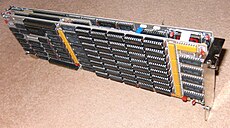
Back Professional Graphics Controller German Professional Graphics Controller Spanish Graafikakontroller Estonian Professional Graphics Controller Finnish Professional Graphics Controller Italian Professional Graphics Controller Japanese 프로페셔널 그래픽스 컨트롤러 Korean Professional Graphics Controller Polish Professional Graphics Controller Russian Professional Graphics Controller Ukrainian
 | |
| Release date | 1984 |
|---|---|
| Architecture | Intel 8088 |
| Cards | |
| High-end | IBM 1501 PGC Matrox PG-640, PG-1280 and QG-640 Dell NEC MVA-1024 Everex EPGA Orchid Technology TurboPGA Vermont Microsystems IM-640 and IM-1024 |
| History | |
| Predecessor | Color Graphics Adapter |
| Successor | VGA, 8514 |
Professional Graphics Controller (PGC, often called Professional Graphics Adapter and sometimes Professional Graphics Array) is a graphics card manufactured by IBM for PCs.[1] It consists of three interconnected PCBs, and contains its own processor and memory. The PGC was, at the time of its release, the most advanced graphics card for the IBM XT and aimed for tasks such as CAD.[2]
Introduced in 1984,[3] the Professional Graphics Controller offered a maximum resolution of 640 × 480 with 256 colors on an analog RGB monitor, at a refresh rate of 60 hertz—a higher resolution and color depth than CGA and EGA supported. This mode is not BIOS-supported. It was intended for the computer-aided design market and included 320 KB of display RAM and an on-board Intel 8088 microprocessor. The 8088 ran software routines such as "draw polygon" and "fill area" from an on-board 64 KB ROM so that the host CPU didn't need to load and run these routines itself.[3] While never widespread in consumer-class personal computers, its US$2,995 (equivalent to $8,800 in 2023) list price, plus $1,295 display, compared favorably to US$50,000 dedicated CAD workstations of the time (even when the $4,995 price of a PC XT Model 87[4] was included). It was discontinued in 1987 with the arrival of VGA and 8514.
- ^ IBM Personal Computer Professional Graphics Controller Technical Reference (PDF). lBM Corporation. August 15, 1984.
- ^ Elliott, John (August 11, 2010). "Professional Graphics Controller Notes". John Elliott's homepage. Retrieved 2014-06-19.
- ^ a b "Announcement Letter Number 184-112 dated September 10, 1984: IBM 5175 PERSONAL COMPUTER PROFESSIONAL GRAPHICS DISPLAY AND PERSONAL COMPUTER PROFESSIONAL GRAPHICS". IBM United States. 10 September 1984. Retrieved 2016-08-08.
- ^ "Announcement Letter Number 183-082 dated June 7, 1983: IBM PERSONAL COMPUTER AND IBM PERSONAL COMPUTER XT ENHANCED WITH ANNOUNCEMENT OF MATH CO-PROCESSOR". IBM United States. 1983-06-07. Retrieved 2023-04-06.